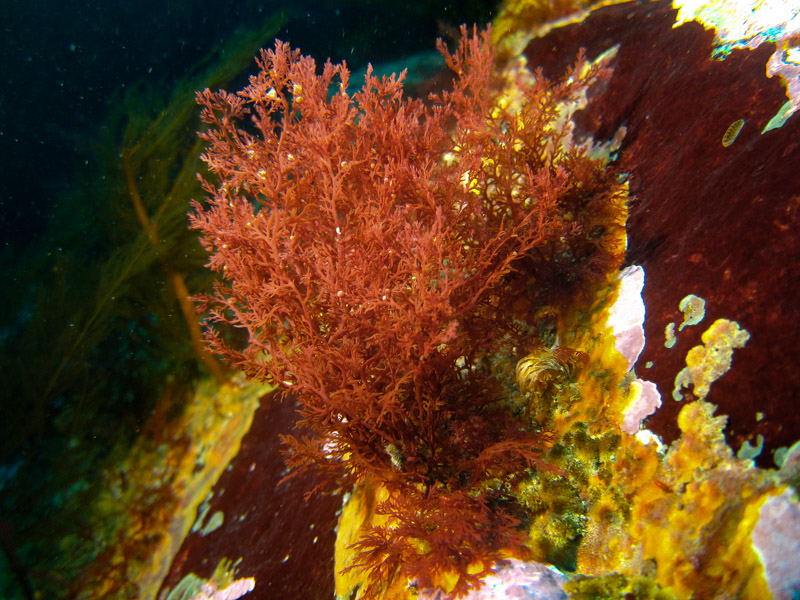
If you consult Wikipedia (I would not recommend it as a scientific source though) you will read that “a transect is a path along which one counts and records occurrences of the species of study (e.g. plants)”. Well, we are not only recording but also collecting our plant/algal species of study Plocamium cartilagineum or Ploc.

Our transect dives differ a little bit from our usual two-buddy-team dives in that three of us go in the water at the same time. This makes for a very crowded zodiac as we need to have three tenders (to get the divers ready before the dive and back into the boat after the dive), diving gear for three people, three divers and enough buckets (usually three) to bring back all the samples we collect.

Usually the sites we go to, we have already scoped before, so we know what depths we can find Ploc at and where we run the transects. At each site, we run three transects (in 3-6 separate dives) from deep to shallow. We stop at 10 feet intervals (starting at 96 feet, working our way up). At each depth, Chuck records the seaweed cover at that depth and the different species he can see on a slate. Andrew and I collect 5 individuals of Ploc. In order to tell them apart afterwards, we came up with a bag system which includes a long sleeve made out of window screening and freezer bag clips. This way we can separate each individual from the next. When we advance to the next depth, Andrew and Chuck get out the tape measure and measure the distance on the slope that we are swimming up on to get an idea of how steep it is.

Why are we interested in this? As I mentioned before in “All-inclusive amphipod hotels in Antarctica”, different Ploc individuals are producing different chemical defenses against grazers. We are trying to find out whether there is a pattern to the madness as we are hoping to shed light on why we see such drastic differences between individuals. Seaweeds are incredibly important for the ecosystem by providing living space, nursery homes and food for a variety of other organisms. Their chemical defenses impact who can eat them and who hides in the seaweed to get protection from other predators. Similar to anemone fish (as in the movie Finding Nemo) who hide inside anemones from their enemies. Understanding why Ploc and its chemical defenses are distributed the way they are will therefore help us understand why the ecosystem is structured the way it is.

So, when we bring the samples back to the lab, we usually take a picture of each individual, then Michelle takes a genetic sample and Andrew takes a sample for chemical analysis. If there is enough left over, CJ will take a piece and press it for our herbarium collection (see my previous blogpost: “What’s your name”).

In the image above you can see an example of the distribution of the defensive chemicals between five individuals at each depth. The different colors indicate different chemical defenses. As you can see, one depth only has chemogroup yellow, whereas two of the other depths have yellow and grey present whilst the shallowest depth has four different chemogroups present. As I explained in “A reunion of the sciency kind”, the distribution we are seeing could have to do with differences in the immediate or micro-environment. The other option is, that it is purely genetics (like you and me having different hair and/or eye color). So, when I get back to Birmingham, I will analyze all the transect samples we collected for gene flow. This means that I will look at how closely individuals are related to each other. If it is based on genetics, we would expect that all the ones with “yellow” chemical defenses are more closely related to each other than those with different types of chemical defenses. Just like you inherit your eye and hair color from your parents. As the season is winding down and we are ready to get home, part of me is sad to leave and another part of me is to get all the samples home and start the labwork there!
